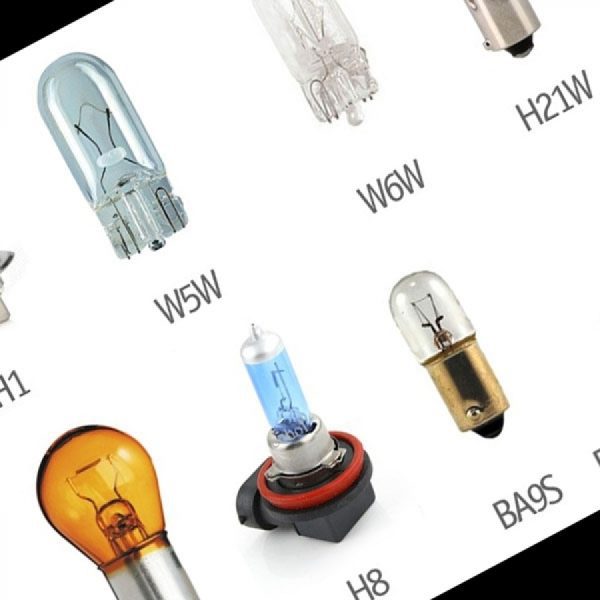
Automotive lamp bases: designation and types
Content
Any modern car is equipped with a large number of bulbs that provide vehicle illumination at night. It would seem that it could be easier than a car light bulb. In fact, when choosing a suitable modification, you can get confused whether a particular element will fit the optics or not.
A large number of companies are engaged in the production of auto lamps around the world. During the manufacturing process of light sources, different technologies are used, so a light bulb from one car may not fit the headlight of another car. Depending on what type of lamps is used in optics, a large number of different elements can be included in its design.
But no matter how high-quality the lighting element is, it cannot be used in any headlight without a base. Let's talk about what the base of automobile lamps is, in which systems it will be used, what are the varieties, as well as the marking features of each of them.
What is a car lamp base
A base is an element of an automobile lamp that is installed in a socket. The car cartridge differs from the classic analogue, which is used in ground electrical installations (buildings connected to the mains), in its design. In standard household bulbs, the base is threaded. In machines, many chucks use a different type of fixation.
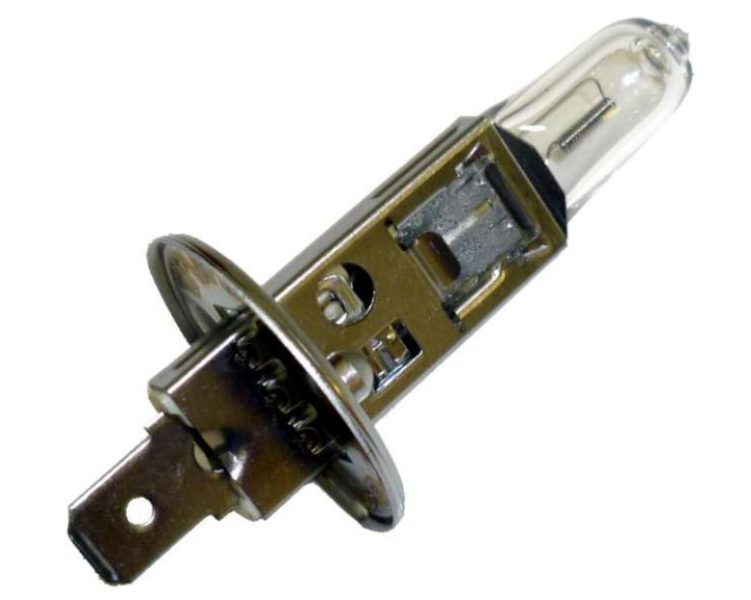
All automotive lighting can be conditionally divided into two categories (details about the types of auto lamps are described here):
- Head light source (headlights);
- Additional light.
Some people mistakenly believe that the most important are the bulbs that are installed in the headlights. Although it is impossible to move around with inoperative head optics in the dark, problems with additional lighting can also result in serious problems for the driver.
For example, during a forced stop on the side of the road, the driver must turn on the side light (if it is dark). In a separate article explains in detail why it is needed. But in a nutshell, in this case, the backlight allows other road users to notice a foreign object on the road in time, and to go around it correctly.
Traffic accidents are frequent at busy intersections in big cities. This often happens due to the fact that one of the drivers did not turn on the turn. Often such situations are provoked by faulty repeaters of turns. When the brake light comes on, the driver behind the vehicle is promptly warned that he needs to slow down. But if the taillight is faulty, then sooner or later it will also cause an accident.
The car interior also needs high-quality lighting, especially if the car moves at night. Although the dashboard and center console during the operation of the side lights, a bright bulb inside the car is indispensable. For example, during a stop, a driver or passenger needs to quickly find something. It is inconvenient to do this with a flashlight.
The auto lamp base device includes the following elements:
- Contact elements - connected to filaments;
- Playground;
- Nozzle. A flask is inserted into it and firmly fixed. This ensures the tightness of the bulb, which preserves the filament;
- Petals. They are created for the design of the cartridge, so that even an inexperienced motorist can competently replace the element.
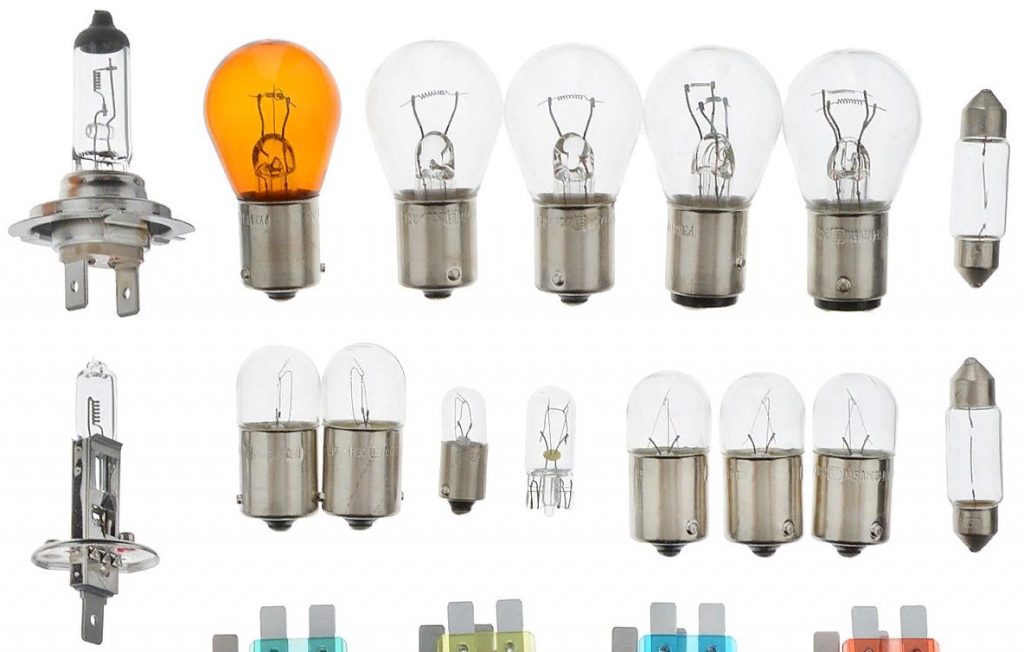
Most of the modifications are made in the form of a platform with several petals. Some provide a strong fixation of the element in the cartridge, while others additionally close the electrical circuit through which current flows into the lamp. This type of base facilitates the process of replacing a failed light source.
Base / plinth technical features
Since the base supports the bulb of the light source, its structure must be much stronger. For this reason, this product is made of heat-resistant plastic, metal or ceramic. An indispensable element of any base are contacts through which electricity is supplied to the filament.
A little later, we will discuss in detail the types of base retainers in sockets. But in short, there is a threaded, soffit and pin type. In order for the driver to quickly select the light bulb suitable for his transport, markings are applied to the base. Each letter and number indicates a feature of the product, for example, diameter, number of contacts, etc.
Base function
Depending on the type of auto lamps, the function of the cap will be as follows:
- Provide contact of electrical wires with the lamp contacts (this applies to all types of socles) so that the current flows freely to the luminous elements;
- Hold the light bulb in place so that it does not move while the vehicle is moving. Regardless of the quality of the road, the headlight of the car can be subjected to vibration to one degree or another, due to which the light element can shift if it is poorly fixed in place. If the lamp moves in the base, over time, the thin wires will break, causing it to stop shining. In case of incorrect placement of the lamp in the socket, the head optics will distribute the light beam with an offset, which in many cases makes driving uncomfortable at night, and sometimes even dangerous;
- Ensure the tightness of the flask. Even if a non-gas type lamp is used, the sealed design preserves the filaments for a long period of time;
- Protect from mechanical (shaking) or thermal (most modifications of lamps emit a large amount of heat during the glow process, and outside the lamp it can be cold);
- Facilitate the process of replacing a burnt out lamp. Manufacturers make these elements from a material that does not corrode.
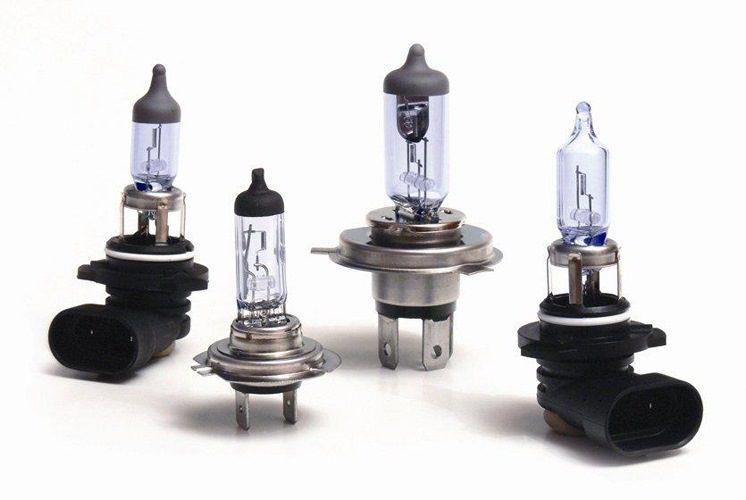
In modern cars, LED headlights are increasingly common. The peculiarity of this modification is that a sealed flask is not required for their operation. Otherwise, they perform the same function as standard counterparts. The peculiarity of all lamp bases is that it is simply impossible to install an inappropriate light bulb into the socket.
Types and description of auto lamp bases
Automotive lamps are classified according to several parameters. Most of them have a national or international standard. All automotive lighting equipment is distinguished by:
- Like the bulb itself;
- Socle.
Previously, lighting elements for cars were not classified, and their marking was not systematized. For this reason, in order to figure out what type of light bulb a particular company sells, at first it was necessary to study how the devices are labeled.
Over time, all these elements have been adjusted to meet national and international standards. While this did not reduce the variety of products, it became much easier for buyers to decide on the choice of a new bulb.
The most common plinths are:
- N4... A lamp with such a base is used in the headlights, and provides a low / high beam mode. For this, the manufacturer has equipped the device with two filaments, each of which is responsible for the corresponding mode.
- N7... This is another common type of car light bulb. It uses one filament coil. To implement the near or far glow, two separate bulbs are required (they are installed in the corresponding reflector).
- N1... Also a modification with one filament, only it is most often used for the high beam module.
- N3... Another modification of single-filament lamps, but there are wiring in its design. This type of bulbs is used in foglights.
- D1-4S... This is a xenon type of lamp with different base designs. They are intended for installation in adaptive optics (for details, read in another review) in which lenses are used.
- D1-4R... Also xenon optics, only the lamp bulb has an anti-reflective coating. Such elements are used in headlights with a reflector.
Caps of the mentioned types are installed in halogen or xenon type headlights. The photo shows an example of what similar bulbs look like.
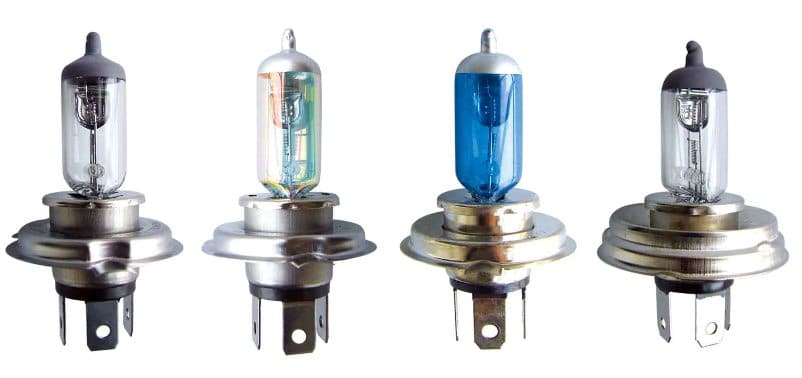
Today there are several types of autolamps, each of which is used in its own lighting equipment. Consider the features of the most common modifications.
With protective flange
Automotive lamp base design, which has a protective flange, is mainly used on high-power light bulbs. They are installed in headlights, foglights and some car spotlights. To designate such caps, the letter P is indicated at the beginning of the marking. After this designation, the type of the main part of the cap is indicated, for example, H4.
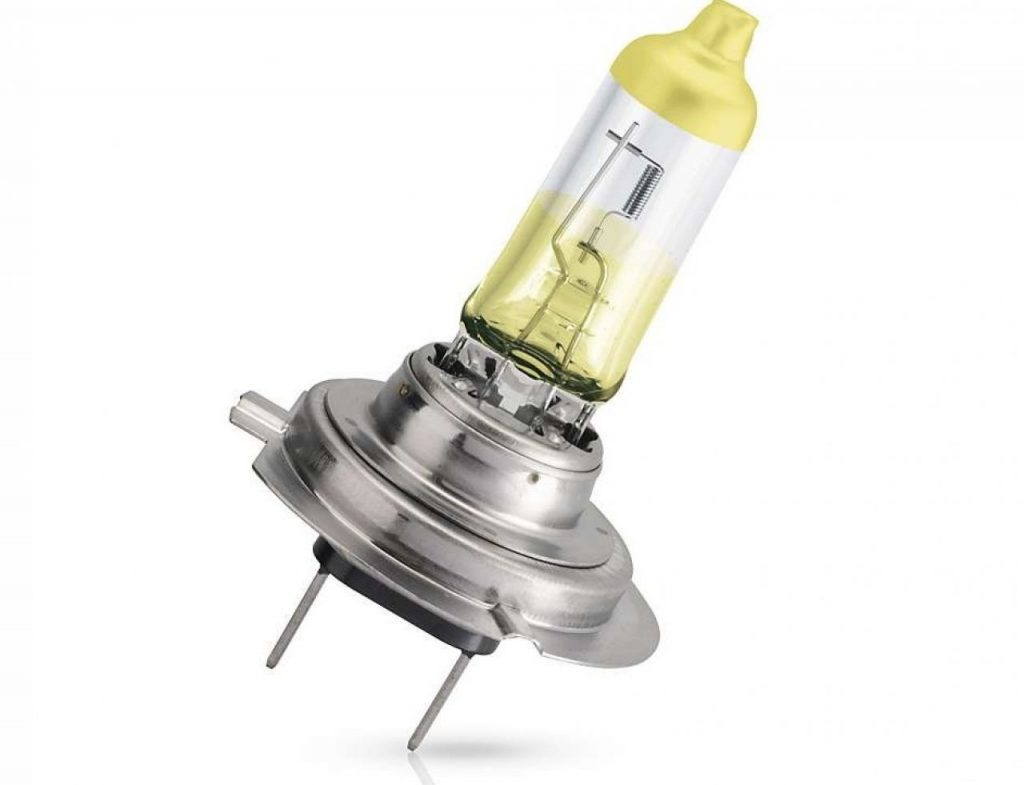
Soffit
Lamps of this type are used in interior lighting. Their peculiarity is in a cylindrical shape, and the contacts are located not on one side, but on the sides. This makes them suitable for use in flat luminaires.

Sometimes such light elements are installed in the license plate light or in the taillights in the brake light module, but more often they are used in interior lamps. Such bulbs are marked with the SV designation.
Pin
The pin-type base has a cylindrical shape, and the lamp is clamped in the holder with the help of solders (pins) on the sides. This variety has two modifications:
- Symmetrical. Designation BA, and the pins are opposite each other;
- Asymmetrical. Designation BAZ, BAU or BAY. The pins are not symmetrical to each other.
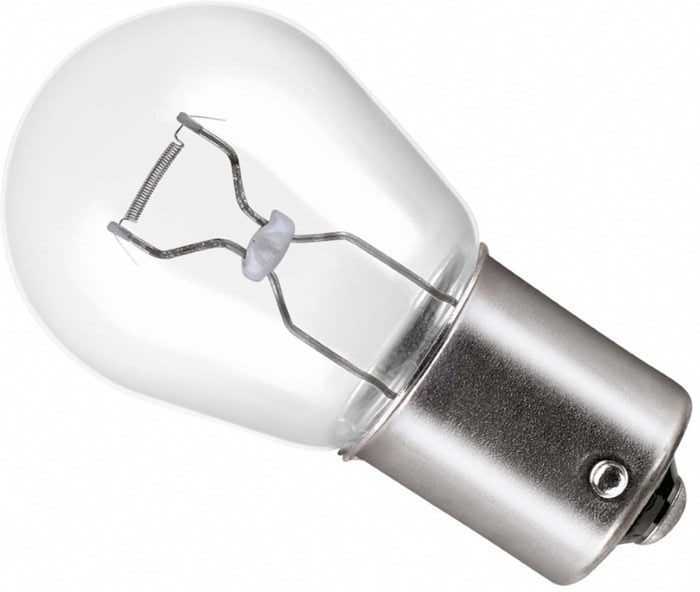
Asymmetric pins prevent accidental insertion of an unsuitable lamp into the module. Such an autolamp is installed in the side light, brake light, direction indicator and other blocks. A domestic car in the rear lights will have a module that provides for the installation of just such lamps. To prevent the driver from confusing the light bulbs in terms of power, their base and sockets have their own diameter.
Glass-base lamps
This is one of the most popular modifications. If there is an opportunity to buy a similar light bulb, many motorists will stop at this type. The reason is that this element does not have a metal base, so it does not rust in the socket. To designate such lamps in the catalogs, W. is indicated. This letter indicates the diameter of the base itself (millimeters).

This type of bulbs has different wattage and there can be quite a lot of them in a car. For example, they are used to illuminate the instrument panel and buttons on the center console. Often they are installed in the license plate illumination unit, in the parking light socket located in the headlamp design.
New types of plinths
Since a lot of attention has been paid to car lighting lately, manufacturers suggest replacing the standard lamp with a similar one, only of the LED type. In the catalogs, such products are indicated by the LED marking. For ease of use, manufacturers can use plinths that are used in standard lighting. There are even options adapted to the head light.
However, modern cars with LED optics are equipped with headlights that imply the use of a special base design. In this case, the product is selected by car model or by VIN number (about where it is located and what information it can provide, read in another article).
We won't talk a lot about the advantages of LED optics - we already have this. detailed review... In short, they create a brighter beam of light compared to standard lamps. They also last longer and consume little electricity.
Deciphering the designations on the bases of automobile lamps
The photo below shows in which lighting modules specific plinths are used:
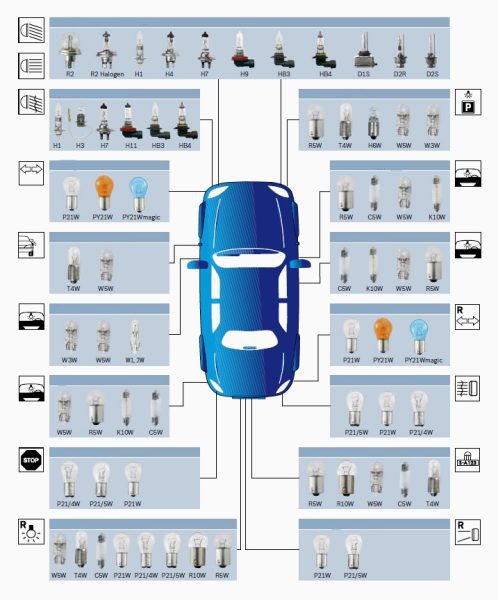
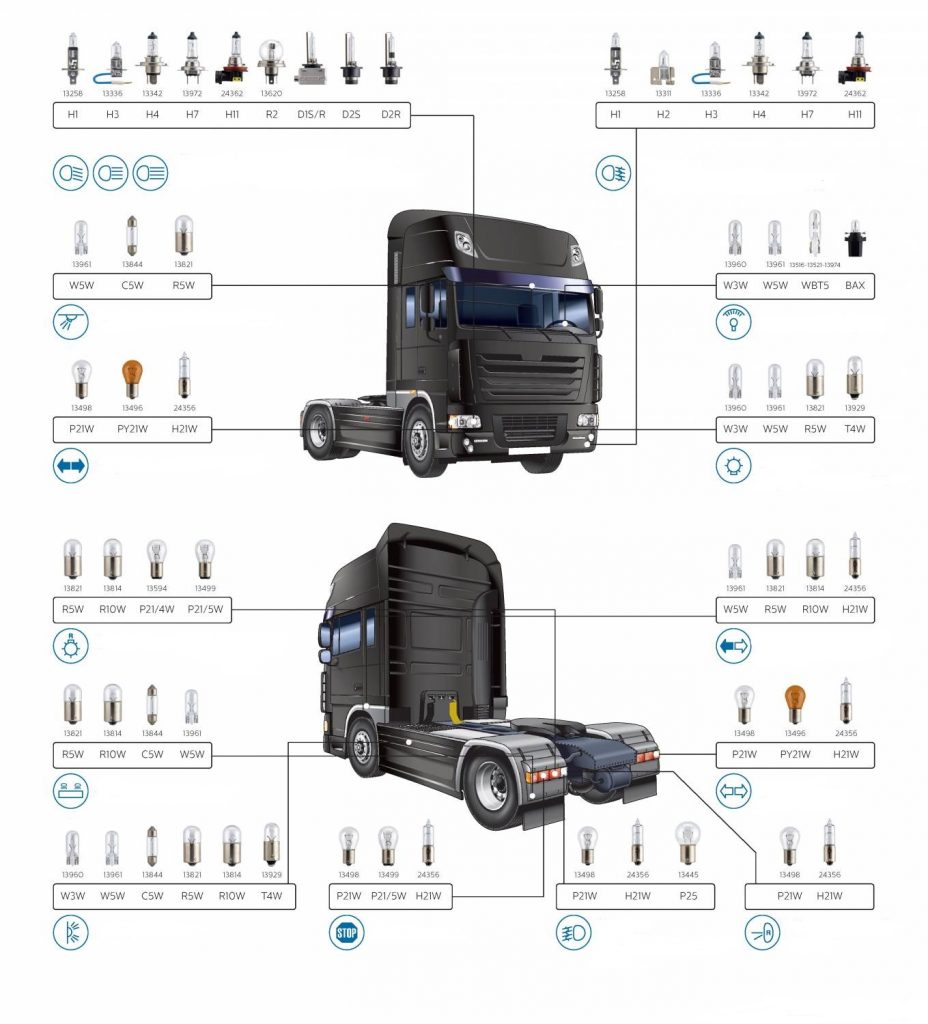
Some motorists face one difficulty when choosing a new lamp. Often, the marking of some lamps is very different from the designations of others, although they are no different in terms of parameters. In fact, the reason is in what standards are used. As mentioned earlier, there is an international and state standard. The first one is unified for machines all over the world, and these components can be manufactured in one country, and the sales market - in several.
With regard to government standards, often such markings will be given to a product that is not intended for export. Consider the basic designations for domestic and foreign auto lamps.
Marking of domestic automotive lamps
The state standard, established during the Soviet era, is still in effect. Such products have the following designations:
| Letter: | Explanation: | Application: |
| А | Car lamp | Unified designation of any type of light bulbs |
| AMN | Miniature car lamp | Instrument lighting, side lights |
| AU | Soffit type autolamp | Interior lights, license plate light |
| AKG | Car lamp of quartz halogen type | Headlight |
Some groups of bulbs have the same lettering. However, they differ in base diameter and power. In order for the driver to be able to choose the right option, the manufacturer additionally indicates the diameter in millimeters and the power in watts. The only drawback of such a marking for domestic transport is that it indicates that it is a car light bulb, but what type is not indicated, so the motorist must know exactly the dimensions of the required element and its power.
European labeling of automotive lamps
Much more often in auto parts stores there are auto lamps with European markings that comply with the ECE standard. At the beginning of the designation there is a specific letter that indicates the following parameters of the lamp itself:
- Т... Small size autolamp. They are used in front marker lights;
- R... The dimensions of the base are 15 mm, and the bulb is 19 mm (diameter of the elements). These bulbs are installed in the tail light in the dimensions module;
- R2. The size of the base is 15 mm, and the bulb is 40 mm (today such lamps are considered obsolete, but on some models of old cars they are still found);
- Р... The dimensions of the base are 15 millimeters, and the flask is no more than 26.5 mm (diameter of elements). They are used in brake lights and turn signals. If this designation is in front of other symbols, then such a lamp will be used as a head light;
- W... Glass base. It is used in dashboard or license plate illumination. But if this letter stands behind the number, then this is simply a designation of the product's power (watts);
- Н... Halogen type lamp. Such a bulb can be used in various car lighting fixtures;
- Y... This symbol in the marking indicates the orange color of the bulb or the glow in the same color.
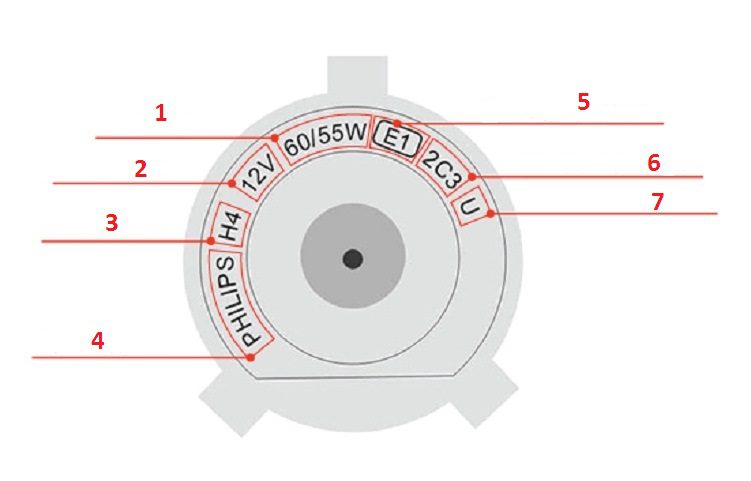
1) Power; 2) Voltage; 3) Lamp type; 4) Manufacturer; 5) Country of approval; 6) Approval number; 7) Halogen lamp.
In addition to the designation of the type of lighting element, the type of base is also indicated in the product labeling. As we said, the variety in the design of this part of the bulb prevents the element from being accidentally inserted into the wrong socket. Here is the meaning of these symbols:
| Symbol: | Explanation: |
| Р | Flanged plinth (if the letter is in front of other designations) |
| VA | Base / plinth with symmetrical pins |
| BAY | Pin modification, only one of the protrusions is slightly higher relative to the other |
| CONSTRUCTION | Radius offset of pins |
| BAZ | In this modification, the asymmetry of the pins is ensured by different positions on the base (at different distances and heights relative to each other) |
| SV (some models use the C symbol) | Soffit type base (contacts are located on both sides of a cylindrical bulb) |
| Х | Indicates a non-standard base / plinth shape |
| Е | The base is carved (mainly used in old car models) |
| W | Glass plinth |
In addition to the designations mentioned, the manufacturer also indicates the number of base / plinth contacts. This information is in lowercase Latin letters. Here's what they mean:
- s. 1-pin;
- d. 2-pin;
- t. 3-pin;
- q. 4-pin;
- p. 5-pin.
Marking car lamps not on the base
The most common bulbs are halogen bulbs. This modification can be produced with different base / plinth designs. It all depends on which system the device is used on. Regardless of the purpose, this type of autolamps is indicated by the letter H at the beginning of the marking.
In addition to this designation, numbers are also used, which indicate the peculiarity of the type of the luminous element and the design of the base. For example, in the marking of foglights of some car models, the numbers 9145 are used.
Lighting color marking
In most cases, car headlight bulbs have a white glow and a clear bulb. But in some modifications, the light source may glow yellow. Thus, you can use transparent white headlights in the car, but the turn signal will still glow in the corresponding color.
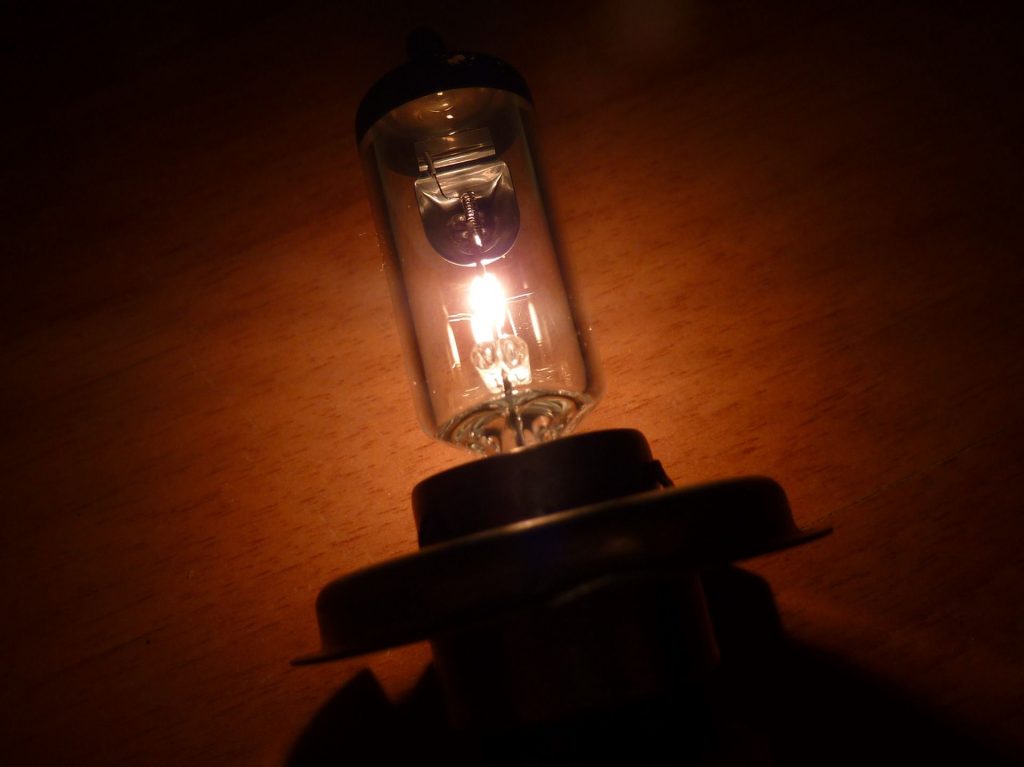
In some car models, these bulbs are installed as visual tuning when replacing standard colored headlights with a transparent analog. Many modern vehicle models are already equipped with similar lighting equipment from the factory, so orange bulbs are used by default. Their marking must contain the Y symbol (stands for Yellow).
Xenon lamp markings
In bulbs, the bulbs of which are filled with xenon, a base of type H or D is used. Similar autolamps are used in various car lighting systems. Some varieties are simply marked with numbers. There are modifications of light sources in which the bulb is able to move inside the cap. Such varieties are called telescopic, and in their marking, these properties will be indicated (Telescopic).
Another type of xenon lamps is the so-called double xenon (bixenon). Their peculiarity is that the bulb in them is double with separate luminous elements. They differ from each other in the brightness of the glow. Typically, these lamps are designated H / L or High / Low, which indicates the intensity of the light beam.
Lamp / base table
Here is a table of the main markings by lamp and cap type, as well as in which systems they are used:
| Car Bulb Type: | Base / plinth marking: | Which system is used: |
| R2 | P 45t | Head optics for low / high beam |
| NV 3 | P 20d | - // - |
| NV 4 | P 22d | - // - |
| NV 5 | RH 29t | - // - |
| H 1 | R 14.5s | - // - |
| H 3 | RK 22s | - // - |
| H 4 | P 43t | - // - |
| H 7 | RH 26d | - // - |
| H 11 | PGJ 19-2 | - // - |
| H 9 | PGJ 19-5 | - // - |
| H 16 | PGJ 19-3 | - // - |
| Н27 W / 1 | GP 13 | - // - |
| Н27 W / 2 | PGJ 13 | - // - |
| D2S | P 32d-2 | Xenon car lamp |
| D1S | HP 32d-2 | - // - |
| D2R | P 32d-3 | - // - |
| D1R | HP 32d-3 | - // - |
| D3S | HP 32d-5 | - // - |
| D4S | P 32d-5 | - // - |
| In 21W | In 3x16d | Front direction indicator |
| P 21W | BA 15s | - // - |
| PY 21W | BAU 15s / 19 | - // - |
| H 21W | FLY 9s | - // - |
| In 5W | In 2.1 × 9.5d | Side direction indicator |
| WY 5W | In 2.1 × 9.5d | - // - |
| In 21W | In 3x16d | Stop signal |
| P 21W | BA 15s | - // - |
| P 21 / 4W | BASE 15d | Side light or brake light |
| W 21 / 5W | In 3x16g | - // - |
| P 21 / 5W | FLY 15d | - // - |
| In 5W | In 2.1 × 9.5d | Side light |
| T 4W | BA 9s / 14 | - // - |
| R 5W | BA 15s / 19 | - // - |
| R 10W | BA 15s | - // - |
| C 5W | SV 8.5 / 8 | - // - |
| P 21 / 4W | BASE 15d | - // - |
| P 21W | BA 15s | - // - |
| In 16W | In 2.1 × 9.5d | Reversing light |
| In 21W | In 3x16d | - // - |
| P 21W | BA 15s | - // - |
| W 21 / 5W | In 3x16g | - // - |
| P 21 / 5W | FLY 15d | - // - |
| NV 3 | P 20d | Front fog lamp |
| NV 4 | P 22d | - // - |
| H 1 | P 14.5s | - // - |
| H 3 | HP 22s | - // - |
| H 7 | PX 26d | - // - |
| H 11 | PGJ 19-2 | - // - |
| H 8 | PGJ 19-1 | - // - |
| In 3W | In 2.1 × 9.5d | Parking lights, parking lights |
| In 5W | In 2.1 × 9.5d | - // - |
| T 4W | BF 9s / 14 | - // - |
| R 5W | BA 15s / 19 | - // - |
| H 6W | PX 26d | - // - |
| In 16W | In 2.1 × 9.5d | Rear direction indicator |
| In 21W | In 3x16d | - // - |
| P 21W | BA 15s | - // - |
| PY 21W | BAU 15s / 19 | - // - |
| H 21W | FLY 9s | - // - |
| P 21 / 4W | BASE 15d | Rear fog light |
| In 21W | In 3x16d | - // - |
| P 21W | BA 15s | - // - |
| W 21 / 5W | In 3x16g | - // - |
| P 21 / 5W | FLY 15d | - // - |
| In 5W | In 2.1 × 9.5d | License plate illumination |
| T 4W | BA 9s / 14 | - // - |
| R 5W | BA 15s / 19 | - // - |
| R 10W | BA 15s | - // - |
| C 5W | SV 8.5 / 8 | - // - |
| 10w | SV 8.5T11x37 | Interior and trunk lights |
| C 5W | SV 8.5 / 8 | - // - |
| R 5W | BA 15s / 19 | - // - |
| In 5W | In 2.1 × 9.5d | - // - |
When planning to purchase new car lamps, you should first pay attention to the type of base, as well as the power of the device that should be used in a particular module. The easiest way to do this is to dismantle the failed light bulb and pick up a similar one. If after the accident the lamp has not survived, then you can choose the appropriate option according to the table above.
In conclusion, we offer a short video review of common modern car lamps and a comparison which is better:
Questions and answers:
What are the bases for car lamps? Head light H4 and H7. Fog lights H8,10 and 11. Dimensions and side repeaters - W5W, T10, T4. The main turn signals are P21W. Taillights W21W, T20, 7440.
How do you know which lamp base? For this, there are tables with the letter and number designation of car bulbs. They differ in the number and type of contacts on the base.

